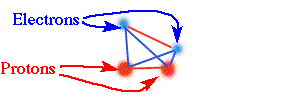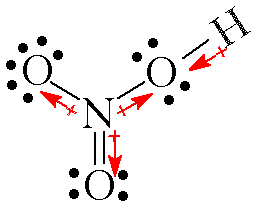Answers
to Self Test on Covalent Bonding
Dr. Walt
Volland revised March 28, 2005
|
|
Short
essay questions
|
|
1.
|
What
are the sources of repulsions and attractions in the hydrogen molecule.
Give answer in terms
of nuclei and valence electrons.
|
|
|
|
|
|
Answer: The
illustration shows a "freeze frame" picture of the electrons and protons
in a H2
molecule
at
a random instant. The positions are changing.
The
red lines indicate repulsions. The blue lines indicate attractions

|
|
|
|
|
|
Repulsions
result from interaction of one electron with the other electron and
the interaction of one nucleus
with the other nucleus.
|
|
|
Attractions
result from the interaction of the electrons with their own nucleus
and with the nucleus in the other
atom.
|
|
|
|
|
2.
|
What
is the origin of the octet rule? Is it universally followed?
|
|
|
If
any exceptions exist, what causes them?
|
|
|
The
octet rule arises from the fact that the ns and np subshells can hold
only a maximum of
eight
electrons.
|
|
|
The
row 2 elements cannot have more than 8 electrons in the "2s2p" subshells.
The octet
|
|
|
rule
is usually followed by C, N, O , and F in row 2. They can form a maximum
of 4 bonds.
|
|
|
The
elements in the other rows do not always follow the octet rule.
|
|
|
The
exceptions to the octet rule result when atoms can use "d" subshells
to form bonds.
|
|
|
This
means an atom can form 5, 6 or 7 bonds using (n-1)d ns np subshells.
|
|
3.
|
Give
the names for the following compounds.
|
|
|
HCl,
PCl5, NO2,
Cl2O5,
CO, CO2, N2O4,
SO3
|
|
|
Answer:
|
|
|
HCl,
hydrogen chloride. This is the pure compound and
should not be confused with the aqueous
solution that is HCl(aq) hydrochloric acid.
|
|
|
PCl5,
phosphorus pentachloride
|
|
|
NO2,
nitrogen dioxide
|
|
|
Cl2O5,
dichlorine pentoxide
|
|
|
CO,
carbon monoxide
|
|
|
CO2,
carbon dioxide
|
|
|
N2O4
, dinitrogen tetroxide
|
|
|
SO3,
sulfur trioxide
|
|
|
What
does the term binary compound mean?
|
|
|
A
binary compound is any compound made up of two elements like HBr, Cl2O5,
N2O4
|
|
4.
|
Draw
the Lewis dot formula for HNO3. Identify
the central atom and any multiple bonds.
|
|
|
What
is the shape around the central atom in HNO3?
give bond angles
The
shape around the nitrogen central atom is planar triangular or trigonal
planar. These are the same. The
bond angles are close to 120o.
|
|
|
Indicate
the polarity of bonds using +---> arrows . The
electrons shift toward the oxygen end of the
N-O and H-O bonds. This is true in all bonds involving oxygen. (Exception
O-F )
|

|
1.
|
Which
of the following pairs of atoms will form a single covalent bond.
|
|
|
a. Na
and Cl This pair forms an ionic bond
|
|
|
b. He
and He These two rare gas forms no bond
|
|
|
c. Ne
and He This pair of rare gases forms no bondsforms no bond
|
|
|
d. H
and O hydrogen can only form a single bond
|
|
2.
|
Which
of the following molecules contains exactly 24 valence electrons?
|
|
|
a. NO
|
|
|
b. NO2
|
|
|
c. CO2
|
|
|
d. SO3
Sulfur
has 6 valence, each oxygen has 6 valence electrons. 1 x 6 + 3 x 6 =
24
|
|
3.
|
Which
of the following pairs of atoms can form a double bond?
|
|
|
a. He
and He
|
|
|
b. H
and H
|
|
|
c. N
and H
|
|
|
d. N
and O
|
|
4.
|
Which
of the following atoms can form a double bond?
|
|
|
a. C
|
|
|
b. O
|
|
|
c. N
|
|
|
d. all
of these
|
|
5.
|
Which
of the following pairs of names and symbols is incorrect?
|
|
|
a. silicon
tetrafluoride, SiF
|
|
|
b. nitrogen
dioxide, NO2
|
|
|
c. phosphorus
trichloride, PCl3
|
|
|
d. phosphorus
pentachloride, PCl5
|
|
6.
|
Which
of the following sets of elements normally exists as diatomic molecules?
|
|
|
a. nitrogen,
neon, helium, oxygen
|
|
|
b. nitrogen,
oxygen, chlorine, fluorine
|
|
|
c. helium,
neon, argon
|
|
|
d. sodium,
calcium, zinc
|
|
7.
|
Which
of the following molecules is the most polar?
|
|
|
a. hydrogen
chloride, HCl
|
|
|
b. hydrogen
iodide, HI
|
|
|
c. hydrogen,
H2
|
|
|
d. chlorine,
Cl2
|
|
8.
|
Which
of the following molecules contains a multiple bond?
|
|
|
a. methane,
CH4
|
|
|
b. nitrogen,
N2
|
|
|
c. hydrogen,
H2
|
|
|
d. chlorine,
Cl2
|
|
9.
|
The
smallest possible unit of a covalent compound is usually considered
to be a(an)
|
|
|
a. atom
|
|
|
b. cation
|
|
|
c. molecule
|
|
|
d. polyatomic
ion
|
|
10.
|
The
systematic name for ICl3
|
|
|
a. iodine
trichloride
|
|
|
b. iodine
trichlorine
|
|
|
c. iridium
trichloride
|
|
|
d. triiodinechloride
|
|
11.
|
A
double bond exists when two atoms share ______ electrons.
|
|
|
a. two
|
|
|
b. three
|
|
|
c. four
|
|
|
d. six
|
|
12.
|
Carbon
dioxide is a linear molecule. The electronegativity of carbon is 2.5.
The electronegativity
|
|
|
of
oxygen is 3.5. The bond between C and O is considered to be
|
|
|
a. nonpolar
|
|
|
b. polar
|
|
|
c. ionic
|
|
|
d. weak
|
|
13.
|
Water
molecules are polar. This is only possible if the molecule is_________________
|
|
|
a. linear
|
|
|
b. tetrahedral
|
|
|
c. bent
|
|
|
d. pyramidal
|
|
14.
|
What
is the predicted shape the carbon tetrachloride molecule CCl4
|
|
|
a. linear
|
|
|
b. trigonal
planar
|
|
|
c. pyramidal
|
|
|
d. tetrahedral
|
|
15.
|
Which
of the following does not obey the octet rule?
|
|
|
a. phosphorus
pentachloride
|
|
|
b. nitrogen
monoxide
|
|
|
c. sulfur
hexafluoride
|
|
|
d. all
of these
|
|
16.
|
Carbon
in the Lewis dot formula for carbonate ion has _____ single bond(s)
|
|
|
and
_____multiple bond(s).
|
|
|
a. two
...... one
|
|
|
b. two
...... two
|
|
|
c. one
...... none
|
|
|
d. four
...... two
|
Click
here to return to homepage 101-online

